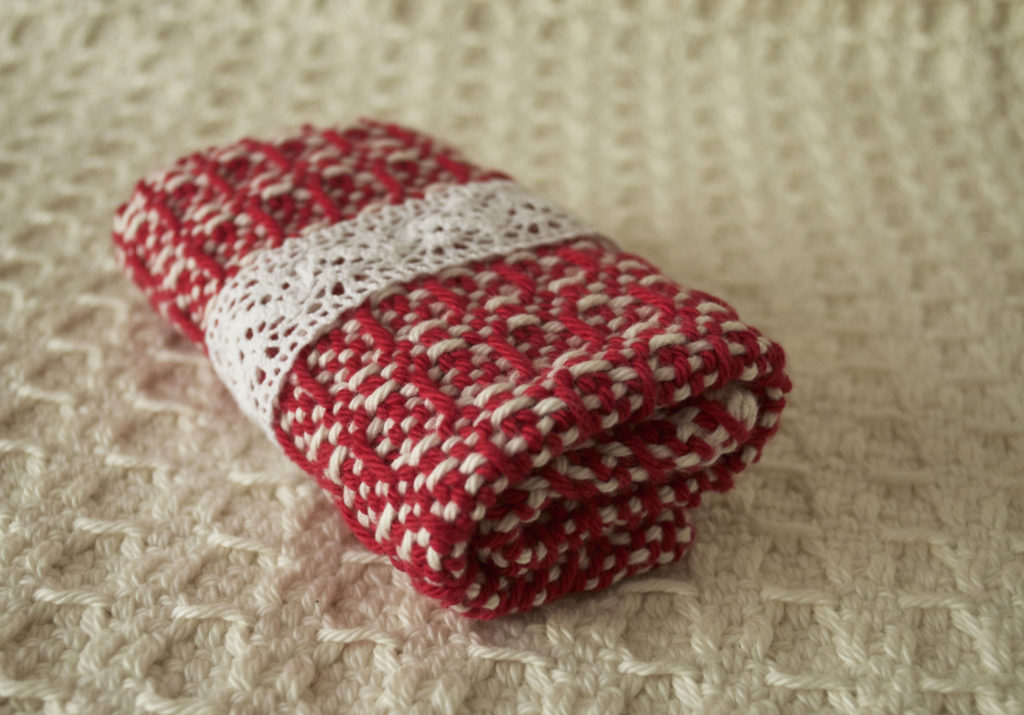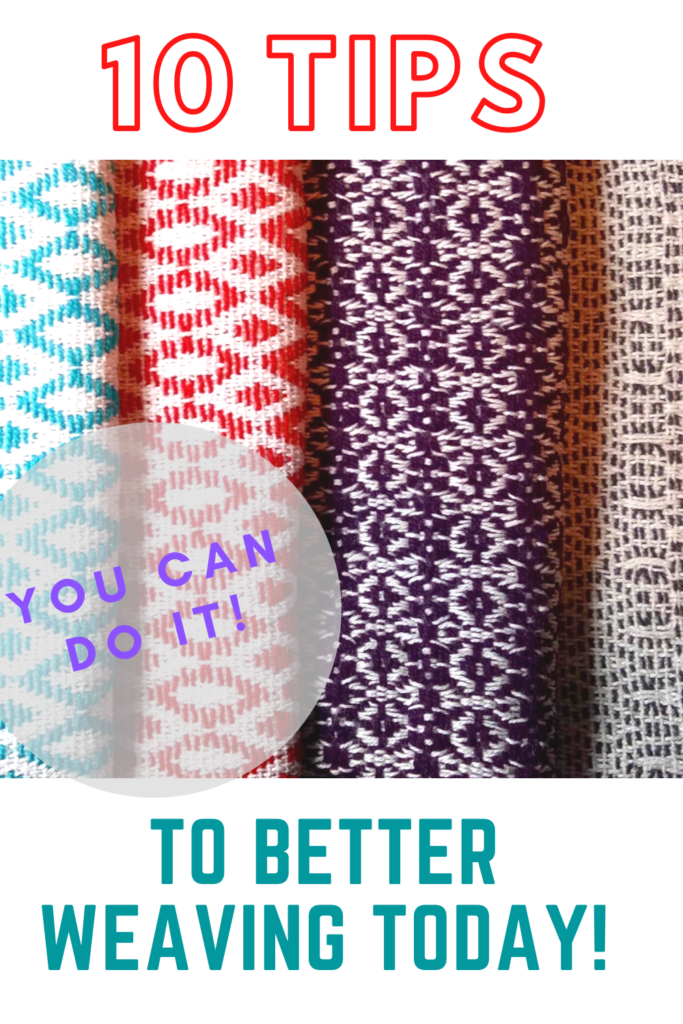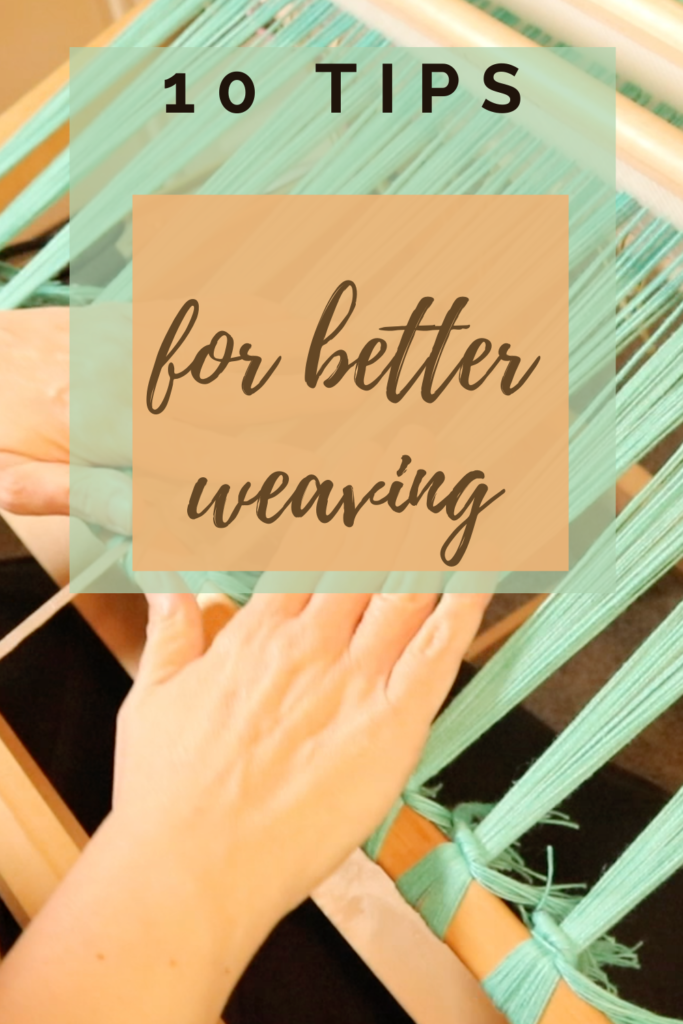Learning to weave is a real journey and it takes time. There is no magic potion or secret ingredient to becoming a better weaver. It takes persistence, time and dedication.
I’ve written a post addressing these facts already – 5 Steps to Successful Weaving, but today I want to give you some short and simple tips that you can do today to improve your weaving.
*This post contains affiliate links
Let’s launch right in!
- Don’t run before you walk.
It’s easy to look too far ahead in your enthusiasm. Enthusiasm is great, in fact, it’s essential, but don’t let it blind you. Start at the level you’re at and work your way up. If you choose something too difficult for your weaving level, you may be setting yourself up for frustration.
2. Don’t choose the best yarn for your first project
The temptation of a gorgeous yarn with a big price tag is real. A beautiful yarn can be the perfect inspiration for a new project. But not as a beginner. And not until you’re confident that the picture you have in your head of your next project is likely to turn out how you want it to. Once again, the frustration will kick in if all doesn’t go as smoothly as you hoped. You have the extra pressure of the yarn price tag hanging over you. Keep the fabulous yarn for when you’re ready.
3. Begin with yarns that have some elasticity
It just makes beginner weaving life so much easier. A yarn with some elasticity (a woollen knitting yarn is perfect) will stretch just enough and is so forgiving that you should not have real issues with tension. Rigid yarns eg. cotton is much harder to tension on a rigid heddle loom. Wool, on the other hand, works with you, rather than you feeling like you’re working with (or for) it.
4. Start with thicker yarns – knitting yarns are perfect.
A thicker yarn (I recommend a light worsted/dk/ Aussie 8 ply) is great to begin with for a couple of reasons. The thickness is usually the perfect match for your standard 7.5 – 8 dent heddle/reed that came with your loom. So, no need to purchase extra sized heddle/reeds right away. It also weaves up much faster, and I think it’s important to make your first few projects very achievable and not be a massive time commitment. This will make you feel better about tackling the next project.
5. Commit regular time intervals to learning by doing
If your loom sits in a cupboard or your garage, guess what? You’re not going to learn how to weave. You’re not going to improve. And you will probably feel bad about it. If you are a busy person (let’s face it, who isn’t?!) then you may even find it beneficial to plan and schedule your weaving time so that it’s enough of a priority that you will weave regularly. I’m of the opinion that it is more beneficial to your learning journey to weave little and often than a big chunk of time occasionally. You’re training your brain to do new things, so consistency is important! Also, if you can have a dedicated space or at least not have to completely pack up everything after every weave session, that will be a great help and motivator.
6. Expect little – you might surprise yourself.
Hope for the best, but don’t place unrealistic expectations on yourself. Learning new skills takes time and patience, there is no way around that. Yes, some will learn quickly and some will take longer and that’s completely normal. If you haven’t seen my Slow Learning video, you should check it out:
7. Record your project information
You’re not being your own best weaving friend if you don’t take the time to record information from your projects to refer back to. You may think you will remember all the details, but chances are you won’t. I learned early on to write things down before, during and after my project. It is so worse the time. It helps you to not repeat annoying mistakes but also allows you to repeat the things that were desirable. My Weaver’s Toolkit downloadable e-booklet is a great help for recording purposes, it includes warping and weaving calculations sheets plus a project record sheet.
8. Sample.
It took me a while to become a true sampling convert. I do it often now. It’s a guaranteed way to know that your project will turn out well. You have to invest a little yarn and time, but it is very satisfying beginning a project with that kind of confidence.
9. Find the right resources for you.
If you need help, find help. The kind of help will be different depending on your needs. You may find weaving books really helpful, (check out my Amazon shop for my favourites) you may want to access some online lessons, or you may be lucky enough to either live near to face to face classes or know someone who weaves already.
10. There is almost always a fix
If you mess up, it’s not the end of the world! Most mistakes can be rectified. You may need to find extra resources when you encounter a problem but that is a positive part of your learning process. I always say that if I hadn’t made so many mistakes I wouldn’t have learned as much as I have. Make sure you’re subscribed to my Youtube channel where I have many, many videos that can help you out of a tricky situation.
11. Do not use sticky yarns if you are a beginner. I repeat, Do not use sticky yarns if you are a beginner!
I know, I said “10 tips” and this is number 11. But I must make this point, it’s that important.
Please! Just don’t do it!! You wouldn’t believe the number of emails I get from students stuck (pun intended) in their project because of a sticky yarn that won’t let them get a clear shed and causes all kinds of angst and hair tearing activity. Even bad language, so I’ve heard.
So, just don’t do it. No fluffy, sticky yarns (just forget all about that mohair for now). Save the stickies for later (if you really want to – I just generally prefer to avoid them!) and plan the project carefully.
If you need more information on choosing appropriate yarns, check out these other articles I’ve written on the topic:
Choosing and Using Yarns in Weaving…
3 Yarns Beginner Weavers should NEVER use!…
What is Superwash Woollen Yarn?…
I hope these tips are useful to you! If you have any questions, please leave me a comment, I love to hear from you.
Until next time…
Happy Weaving!





Well, I finally “made” time to watch this and read through the points made. You are so right, in fact, I am going to type up the key bullets and paste them to the cover of my weaving notebook. I am so bad at feeling guilty, story of my life. I always placed my wants at the end of the list. By the time I got to the end, I am too exhausted. Now, my goal is to move me to the top, schedule chunks of time. Your such an inspiration as I learn. A million thank yous is not enough!!!!!!
❤️❤️❤️
thank you Kelly, for sharing this words. It keeps me on track 🙂
You’re welcome, thanks for reading!
Hi Kelly,
Great tips….thank you!
What pattern is the piece shown above in the slow learning video please? It’s gorgeous!
It’s Monk’s Belt – one of my favourite weave structures 😊
Hi Kelly, thank you so much for the tips! I’ve only been weaving since January so I’m still a newbie. Could you tell me which types of yarn are likely to be “sticky”. I know you mentioned mohair in your blog post but what other kinds should I avoid, at least for a while? Thank you!
Luxury yarns often are. So, apart from mohair, there is Angora, some types of alpaca, possum or rabbit fibres can be. Some wools are definitely sticky too. You can usually see that it clings to itself or has a bit of static even when it’s on the ball. If it has little fibres sticking out or coming off, or looks super fluffy and is a natural fibre, that is a tell tale sign. If it’s coarse or scratchy. But sometimes you only learn through experience!
Thank you!❤️
Thank you. I wish that when the towel faze started that someone would have said that cotton yarn had issues with tension. I spent hours fighting with tension on cotton towels. Thought I would never make another towel. Thought it was just me and my RH.
I am in the process of doing the pinwheel project from your class. I didn’t know one of my yarns was so sticky and it has been a nightmare. However, thanks to the group, I am finally making some headway. I am using a mister with water to help release the threads and it is helping a lot. I also am using pickup sticks to go through the shed prior to putting my shuttle through. It’s costing me some time, but helps me not to be so frustrated and I’m finally making some progress. I love the pattern, but I really learned to be careful which yarns I am using. Thanks for the tips, as a new weaver they are appreciated.
Oh yes, especially when you have a more complicated pattern you’re working on, sticky threads are terrible. I’m really glad you pushed on and found some helpful solutions though!
thanks Kelly, beginner or not, there is always very useful information in your posts, I usually say that something new is learned every day!!!
I definitely agree with that!
Great tips Kelly. A good reminder as well on the importance of regular practice.
Apart from mohair how do you recognise a sticky yarn before you warp?
You can usually see that it clings to itself or has a bit of static even when it’s on the ball. If it has little fibres sticking out or coming off, that is a tell tale sign. If it’s coarse or scratchy. But sometimes you only learn through experience!
Oh Kelly, I wish I had this list before I started weaving. Really helpful tips, many thanks.
I have bookmarked it so I can return to it for a refresher every now and then 🙂